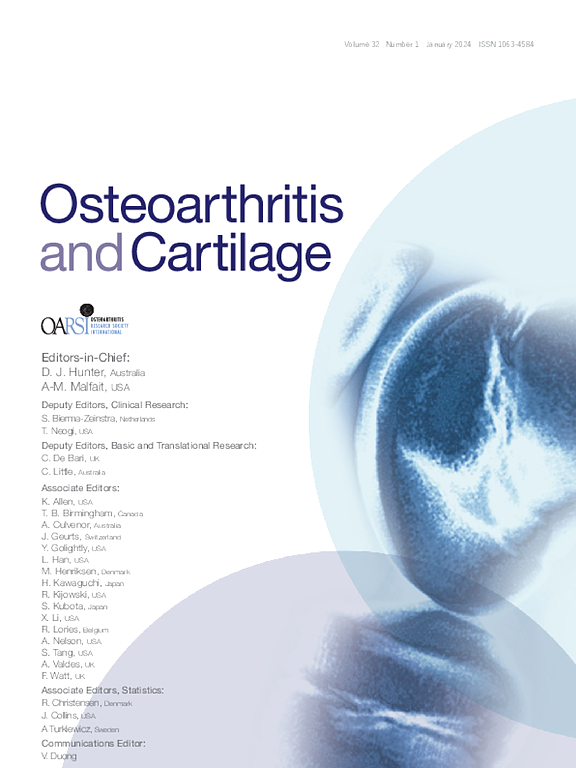MicroRNA signature for early prediction of knee osteoarthritis structural progression using integrated machine and deep learning approaches
IF 7.2
2区 医学
Q1 ORTHOPEDICS
引用次数: 0
Abstract
Objective
Conventional methodologies are ineffective in predicting the rapid progression of knee osteoarthritis (OA). MicroRNAs (miRNAs) show promise as biomarkers for patient stratification. We aimed to develop a miRNA prognosis model for identifying knee OA structural progressors/non-progressors using integrated machine/deep learning tools.
Methods
Baseline serum miRNAs from Osteoarthritis Initiative (OAI) participants were isolated and sequenced. Participants were categorized based on their likelihood of knee structural progression/non-progression using magnetic resonance imaging and X-ray data. For prediction model development, 152 OAI participants (91 progressors, 61 non-progressors) were used. MiRNA features were reduced through VarClusHi clustering. Key miRNAs and OA determinants (age, sex, body mass index, race) were identified using seven machine learning tools. The final prediction model was developed using advanced machine/deep learning techniques. Model performance was assessed with area under the curve (AUC) (95% confidence intervals) and accuracy. Monte Carlo cross-validation ensured robustness. Model validation used 30 OAI baseline plasma samples from an independent set of participants (14 progressors, 16 non-progressors).
Results
Feature clustering selected 107 miRNAs. Elastic Net was chosen for feature selection. An optimized prediction model based on an Artificial Neural Network comprising age and four miRNAs (hsa-miR-556-3p, hsa-miR-3157-5p, hsa-miR-200a-5p, hsa-miR-141-3p) exhibited excellent performance (AUC, 0.94 [0.89, 0.97]; accuracy, 0.84 [0.77, 0.89]). Model validation performance (AUC, 0.81 [0.63, 0.92]; accuracy, 0.83 [0.66, 0.93]) demonstrated the potential for generalization.
Conclusion
This study introduces a novel miRNA prognosis model for knee OA patients at risk of structural progression. It requires five baseline features, demonstrates excellent performance, is validated with an independent set, and holds promise for future personalized therapeutic monitoring.
使用集成机器和深度学习方法早期预测膝骨关节炎结构进展的MicroRNA签名。
目的:常规方法在预测膝骨关节炎(OA)的快速进展方面是无效的。mirna有望成为患者分层的生物标志物。我们的目标是开发一个miRNA预后模型,用于使用集成的机器/深度学习工具识别膝关节OA结构进展者/非进展者。方法:分离OAI参与者的基线血清mirna并进行测序。通过MRI和x线数据,根据参与者的膝关节结构进展/不进展的可能性对其进行分类。为了开发预测模型,使用了152名OAI参与者(91名进展者,61名非进展者)。通过VarClusHi聚类减少MiRNA特征。使用七种机器学习工具确定关键mirna和OA决定因素(年龄、性别、BMI、种族)。最终的预测模型是使用先进的机器/深度学习技术开发的。用AUC(95%置信区间)和准确度评估模型性能。蒙特卡洛交叉验证确保了鲁棒性。模型验证使用来自独立参与者组的30份OAI基线血浆样本(14名进展者,16名非进展者)。结果:特征聚类筛选出107个mirna。选择Elastic Net进行特征选择。基于年龄和四种mirna (hsa-miR-556-3p、hsa-miR-3157-5p、hsa-miR-200a-5p、hsa-miR-141-3p)的人工神经网络(ANN)优化预测模型表现优异(AUC, 0.94 [0.89, 0.97];准确率为0.84[0.77,0.89])。模型验证性能(AUC, 0.81 [0.63, 0.92];准确率(0.83[0.66,0.93])表明了泛化的潜力。结论:本研究为存在结构进展风险的膝关节OA患者引入了一种新的miRNA预后模型。它需要五个基线特征,表现出优异的性能,通过独立的一组验证,并有望用于未来的个性化治疗监测。
本文章由计算机程序翻译,如有差异,请以英文原文为准。
求助全文
约1分钟内获得全文
求助全文
来源期刊

Osteoarthritis and Cartilage
医学-风湿病学
CiteScore
11.70
自引率
7.10%
发文量
802
审稿时长
52 days
期刊介绍:
Osteoarthritis and Cartilage is the official journal of the Osteoarthritis Research Society International.
It is an international, multidisciplinary journal that disseminates information for the many kinds of specialists and practitioners concerned with osteoarthritis.
 求助内容:
求助内容: 应助结果提醒方式:
应助结果提醒方式:


